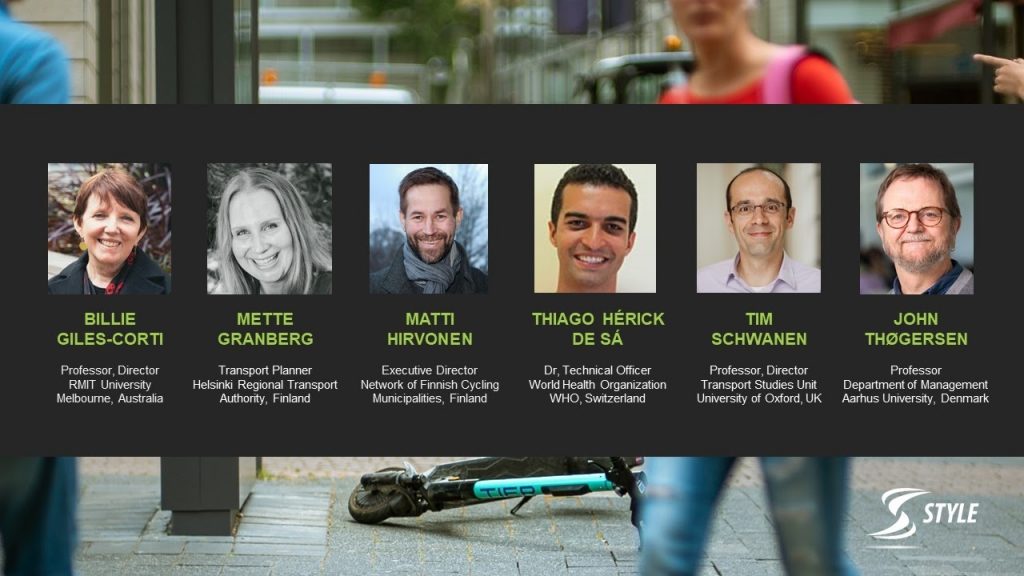Katariina Kiviluoto & Marjukka Parkkinen
On the 29th of April STYLE project organised a webinar called Towards healthy mobility – Transdisciplinary Contribution to Health, Climate and Business Targets. During two hours, six internationally acknowledged experts and practitioners tackled challenges to and solutions for increasing healthy mobility and physical activity from multiple perspectives.
The webinar revolved around four themes of challenges to an active, low-carbon lifestyle identified and documented earlier in the STYLE project. We will document the webinar in a series of four thematic blog posts.

Six panellists on STYLE webinar. Screenshot from presentation.
At the beginning of the event, panellists were asked about the following challenge: Do we lack or disregard knowledge on the advantages of physical activity and daily active transport, and if so, why? Or could it be that we are merely prioritising other aspects than healthy, active lifestyles?
Professor Tim Schwanen (Director of Transport Studies Unit University of Oxford, UK) reminded the audience of the dangers of grand decision-making narratives and framing the issue merely as lack of knowledge. Since we have plenty of information, the remedy is not to provide more knowledge, but rather to critically consider the nature of both information and indicators. However, what we are actually lacking is information on what needs to change and how much, said Professor Billie Giles-Corti (Director of RMIT University Melbourne, AU). There is no point in saying that we need more walkable neighbourhoods, but instead academics should support better decision-making with better evidence, says Giles-Corti. Another well-known challenge in governance is silo thinking. For this, Dr. Thiago Hérick de Sá (Technical officer in the World Health organisation WHO, SUI) called for planning spaces and platforms that allow for effective multi-sectoral work and sharing of different data, interests and knowledge.
One key issue raised in the webinar was the need for more practical tools to support decision-making. One example mentioned by Professor Schwanenis the “Health economic assessment tool for cycling and walking” (HEAT), developed together by WHO and the science community. The HEAT tool is useful in monetising the health benefits of walking and cycling making the benefits more visible for decision-makers. According to de Sá, the HEAT tool is continuously developed, and a new updated version is currently being prepared to ensure a wider global utilisation of the tool. In addition, Professor Giles-Cortitalked about making research more tangible. Decision-makers need indicators and data to make changes happen: what gets measured, gets done. One helpful example provided by Giles-Corti is the Urban Liveability Checklist for assessing liveability and opportunities to improve health and wellbeing in cities. The tool is suitable for both established and proposed urban areas.
Despite the abundance of information, existing knowledge may be disregarded due to other priorities, for example short term gains over long term benefits. Professor Schwanen pointed out that both current planning objectives and tools have their roots in the past, when the main purpose of transport planning was to ensure fast, efficient and effortless transport systems: “We talk about sustainability, but at the end of the day, often, it is economic factors that count more.” Prof. Giles-Corti agreed that cost-effectiveness requires careful attention. Even if cost savings caused by increased physical activity may seem minor at first glance, the savings become substantial when put over the entire population. Next to this, there are additional benefits from e.g. increased productivity.
Finally, if perceived risks outweigh the advantages of physical activity, excessive safety seeking may stand in the way of increased physical activity. Dr. de Sá reminded that addressing safety is not only a health choice but also an urgent need. By delivering healthy and sustainable mobility through interventions, we can maximise health impacts and better anticipate harmful consequences from our actions in the future. According to de Sá, efficient communication is fundamental for successful implementation: the general public and other stakeholders need to be engaged in planning processes concerning safety.
This is the first of four thematic blog posts about the STYLE webinar.
- STYLE webinar blog #1: Promoting healthy mobility with knowledge and decision-making
- STYLE webinar blog #2: Design to support physical activity
- STYLE webinar blog #3: Integrating physical activity to everyday lives
- STYLE webinar blog #4: Silver bullets, lifestyles, feelings and equality enabling physical activity
Further information, recording and slides from the webinar here.
Links:
Kappale
Article picture: pixabay.com

